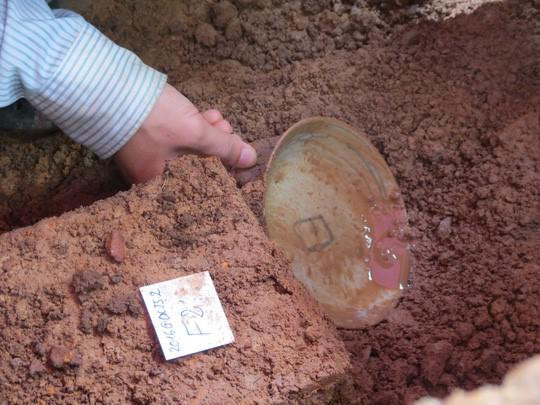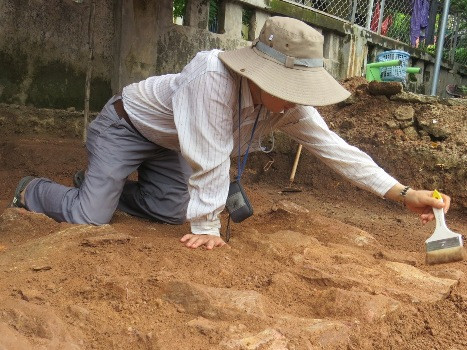Discovered an ancient disc at the place of the burial of King Quang Trung
An ancient plate located at a depth of 1.5 m has been found by archaeologists at the excavation pit in the area of Duong Xuan mound, the place of burial of King Quang Trung.
On the morning of October 12, the archaeological exploration team discovered a disk of jade at the excavation hole before Van Phuoc Pagoda (Truong An, Hue City).
The disc with a diameter of more than 10cm, was discovered in the depth of nearly 1.5m. This is the most intact artifact found so far in five excavations in the area of Binh An hamlet, where researcher Nguyen Dac Xuan said there used to be a Danyang palace. The front of the disc has a Chinese word. The back of the disc has no textures, the date has not been determined.

The ancient plate is intact.(nh: Vo Thanh).
According to the researchers, the discovery of the jade disc contributes to the strengthening of materials for exploration in Duong Xuan mound.
Earlier, at the exploration hole No. 5 at the local house only 13/120 Dien Bien Phu, archaeologists discovered a layer of overlapping stones. At the exploration hole at the Boat Lam Pagoda, archaeological officials also found a broken glass and some broken bricks and tiles.

The stone layer was discovered at Hole 5 of a civilian house.(Photo: Vo Thanh).
Associate Prof. Dr. Bui Van Liem - Deputy Director of Institute of Archeology said that many artifacts have been discovered in 5 holes such as copper, iron, chinaware, porcelain with signs of architecture. However, it is unclear whether the existence of citadels, palaces or burial sites in this area is not clear, so further exploration is needed.
Chronology of artifacts is being determined.
The exploration of Duong Xuan mound (Truong An, Hue City) with an area of 22 m2 was carried out by the Thua Thien - Hue History Museum in collaboration with the Institute of Archeology from September 30 to October 15. t
- Detecting strange ground in archaeological area to find King Quang Trung's grave
- Digging for the tomb of King Quang Trung after more than 200 years
- Revealed 70 ancient tombs tilted in Old Horse Horse
- First find the burial place to cut the mysterious belly of King Arthur
- Egypt examined Tut's tomb to find Queen Nefertiti
- The grave is filled with gold-clad grave belongings of King Tut
- The 4,000-year-old burial room of the ancient Egyptian official
- The goal is that few people know of burial on trees
- Duong Long tower may be the place where Cham king was buried
- Mysterious beauty in the ancient tomb of the king is full of gold
- Ship 016-Quang Trung: The largest and most modern battleship in Vietnam is surprisingly beautiful
- Mexico discovered an ancient burial site dating back to 800 years
 Discovered an ancient centipede fossil 99 million years old
Discovered an ancient centipede fossil 99 million years old Discovered bat-like dinosaurs in China
Discovered bat-like dinosaurs in China Discovered a 200-year-old bronze cannon of the coast
Discovered a 200-year-old bronze cannon of the coast Discover 305 million-year-old spider fossils
Discover 305 million-year-old spider fossils